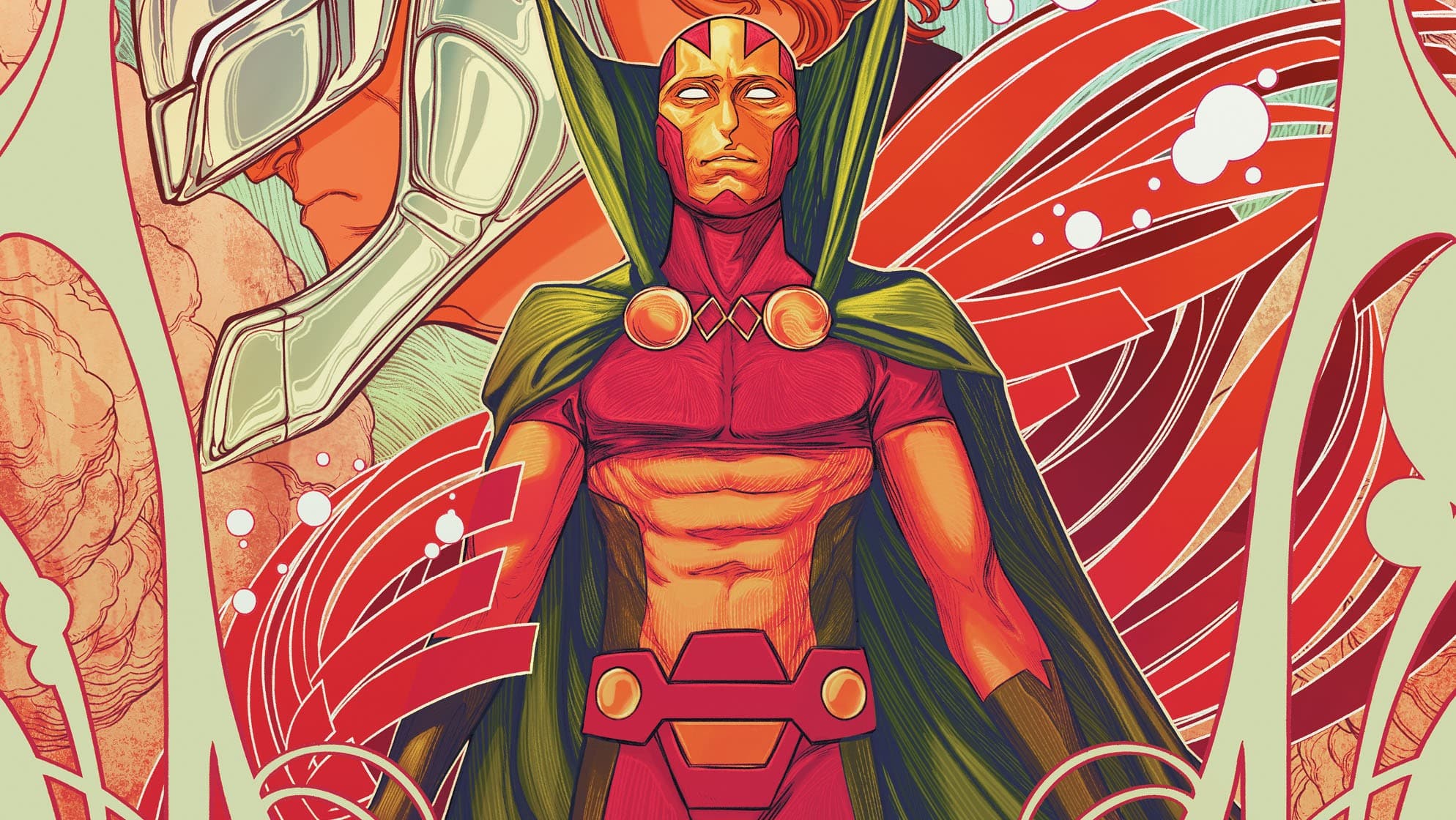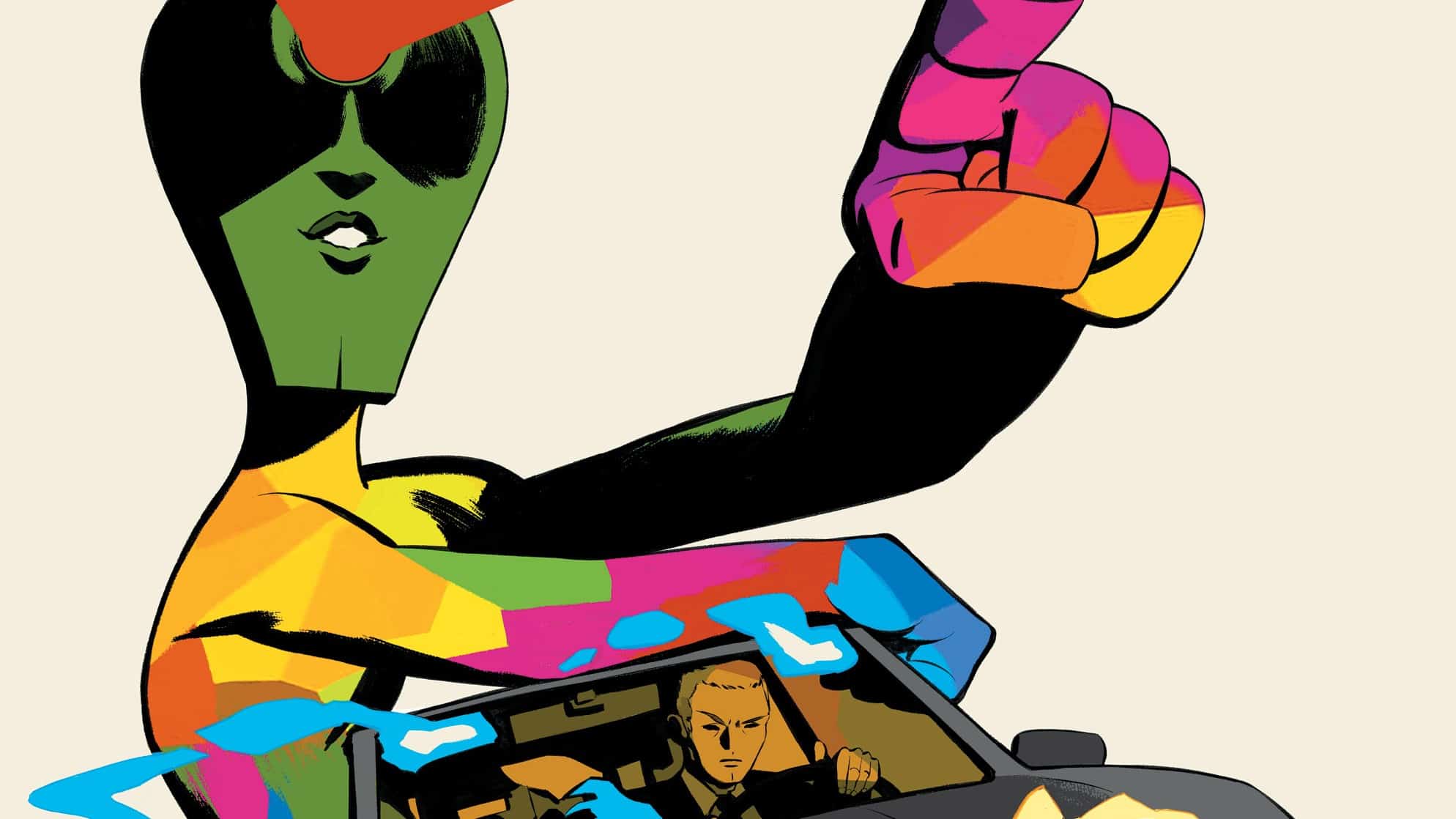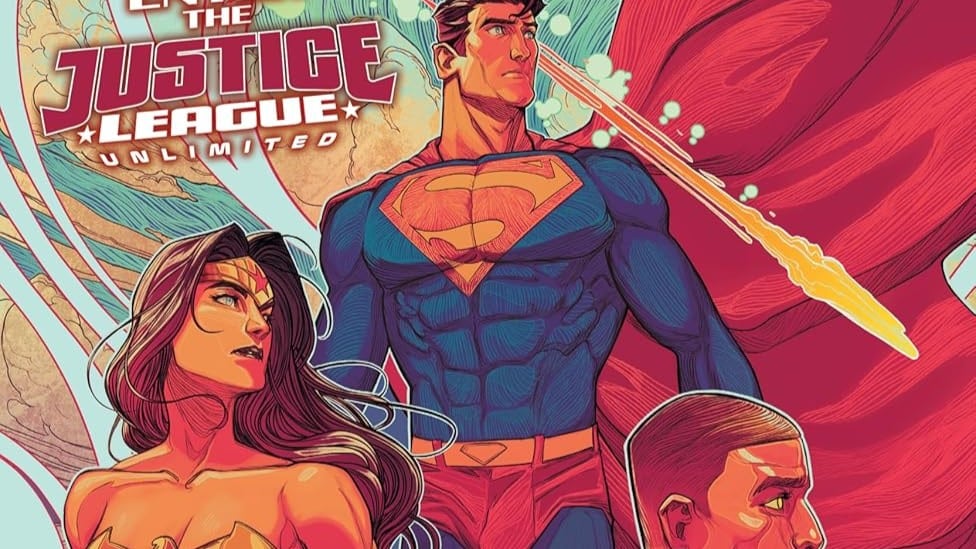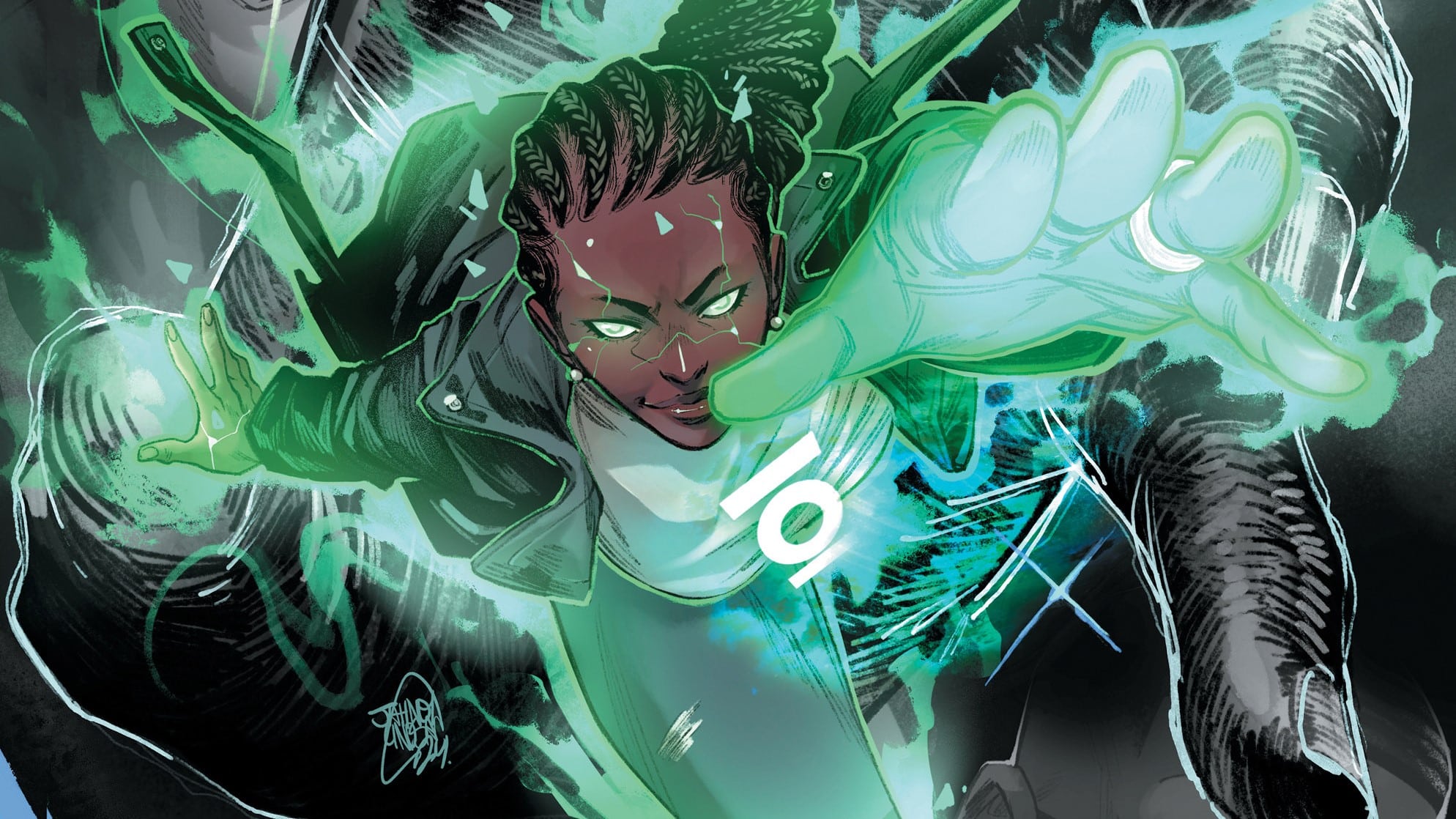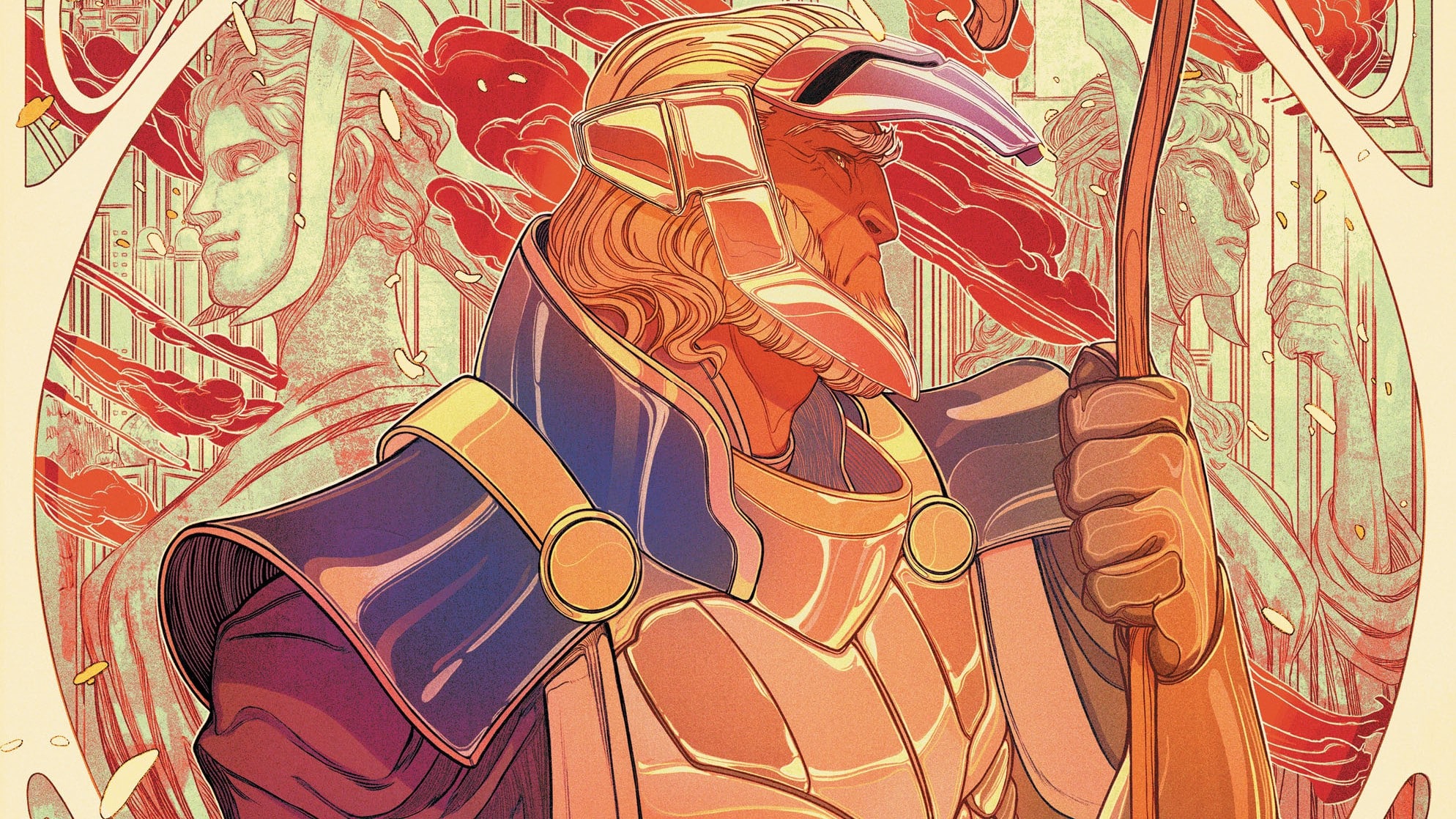Darkseid is dead. And to some, it looks like the rest of the New Gods aren’t far behind. Prophecies and destinies rear their ugly heads, as skies darken and declare the end of everything the gods of New Genesis and Apokolips hold dear. Big things are afoot, and everyone is scrambling — for power, for peace, for survival — but is it too late for everyone involved? New Gods #2 is written by Ram V, drawn by Evan Cagle with guest art by Jesse Lonergan, colored by Francesco Segala and lettered by Tom Napolitano.
I’ve been going back, reading through Jack Kirby’s Fourth World comics from the early 1970s, and as I bounce from issue to issue, I gotta say, Mister Miracle is my favorite. Aside from everything else that makes the comic great, it’s got that gimmick, a delightful draw: What is Mister Miracle going to be escaping this time?
In this issue, it’s a mix of dread and guilt. The guilt that threatens to overwhelm him if he chooses to do nothing to save an innocent child, and the dread of being drawn into an eons-old conflict he has worked so hard to be free of. The thing is, Scott Free isn’t the only one dealing with dread and guilt — everyone in this comic is defined, in some way, by how they’re dealing with those two qualities. Some, like Scott, have both in spades, while others are clear of them entirely.
Dread and guilt. As New Gods #2 continues to set up the board for confrontation across the cosmos, we take a look at just how well this series’ players (or pawns) have escaped these two gut-wrenching qualities — a peek into how their minds work, and a possible glimpse into just how all of them are going to act when the Source hits the fan.
Dread Will Not Be Silenced

Last issue began with pages from guest artist Jorge Fornés — four pages of cosmic spectacle, meant to take your breath away and send chills down your spine. Jesse Lonergan’s opening pages as guest artist don’t hit as hard, or quite the same way. They’re muddier. More grounded. Not the opening notes of a grand epic, these pages speak more to the chaos of myth, and the mess that comes with stories that have existed for a very long time.
We’re introduced to new character Karok Ator, an alien warrior. One who, for reasons unknown, has placed a target on the backs of any with a touch of the Source in their veins, whether they be simple creatures who have lucked their way into absorbing some of these cosmic powers, or the New Gods themselves.
We’re treated to a wild and vibrant spread of panels showing us various New Gods and Source-touched characters from around the universe, panels cut up from interlocking circles and the spaces in between, all vibrantly colored — visions of elsewhere sandwiched between moments in the present; between Karok and his newest victim. Karok efficiently, brutally and very publicly destroys a nameless, Source-touched monster. There is no mercy, no trial, no negotiation — it is an execution for the cheers of the crowd.
These pages are more grounded. More grim. Something ugly is coming, something that cares little for prophecy or cosmic purpose. It’s a brutish, violent death that approaches, and it’s coming for everyone.
The next page isn’t any more soothing. Words of fire burn across the page (which I may or may not have spent an hour deciphering), burning oranges, reds and yellows starkly contrasted with cold blues tell of an apocalyptic ending. The Highfather dreams of the end — he is filled with dread for the end of all things. It is a dread that leaves no room for guilt. He may have ordered the death of a child — but his only regret is that it has not already happened.
Once again I am struck by just how beautifully Evan Cagle portrays emotion through body language. Cagle’s figures have a certain fluidity to them — proportions stretch to fit feelings, clothing folds dramatically over bodies, eyes go as wide as they need for emotions to be conveyed as clearly as possible. The Highfather fears the end of things — there is nothing he won’t do to keep the things he holds dear safe.
His conscience is not one of those things.
Guilt Will Not Be Ignored

With dread heavy in our minds, we move to our apparent lead, watching as Mister Miracle attempts to sum up his feelings, and his reasons for leaving, in a letter to his wife and child. Here, we see dread and guilt in equal measure, as I mentioned earlier.
It’s all for naught, however, as Barda confronts him before he can even begin to get away.
I am tired of the trope of lone male heroes leaving behind their loved ones to protect them, so I am glad to see it so quickly subverted here. Barda is a hero with neither dread nor guilt, simply possessed of the need to get the job done, be it saving the world or raising a daughter, neither task no less awesome than the other. The interplay is great here. Scott — especially while in full costume that turns his eyes into cartoonishly wide, white ovals — is a goofball burdened with purpose. There is a softness in his smile as his plans to bear this burden alone are dashed. Barda, our straightwoman, takes her part of the burden with apparent ease — there is no room in her for nonsense, not when her husband has that covered. As upset as Barda is with Scott, there’s understanding there. We may only get two pages with these two, but it is wonderful.
We move from Glendale to Mangalore to follow Kiran and Mira, the parents of the prophesied child. The crowded Mangalorean street is a mess of dust, of electric wires, of rickshaws and tacky neon signs, and it’s the standout panel of the issue; one I’ve been looking forward to seeing ever since Ram V teased it in November. Cagle and colorist Francesco Segala have such a wonderful sense of location — able to switch effortlessly from that beautiful, crowded chaos to the quietness of the room where Kiran and Mira hide their child.
Kiran and Mira’s dread pales in the face of their guilt. Guilt for the child they lost, guilt that fuels their need to keep their miracle temple foundling safe. Guilt that burns away fear and turns it to bravery. This child is their redemption, and they will do everything they can to keep him safe. The story revolves around this Indian family, but we know so little about them — but that is the problem with those at the heart of a prophecy. They are part of a story so much bigger than themselves. They are barely protagonists — they are the bearers of this story’s catalyst. They remain the same as everything changes around them. I spoke earlier of players and pawns, and Kiran and Mira — even their child, at this point in the story — are definitely pawns.
The Gravity of Stories

Someone who definitely is a player in this story, however, is Evil CEO Maxwell Lord (the story hasn’t used his first name yet, but it’s pretty clearly Max). Max has neither guilt nor dread. His privilege has freed him from such things. He has all the confidence of a very rich white man who believes the world belongs to him. That nothing is sacred, that the brutal acquisition of power is a game, that people are nothing but pieces on a board — though Max himself is a pawn in whatever game Metron is playing.
Metron’s motivations are unclear. He seems to be unaccustomed to guilt or dread — but he is keeping his cards close to the chest. He has set many things into motion, on New Genesis, on Earth, even on Apokolips, as he heralds the fall of the latter planet with a prophesied eclipse.
I spoke of last issue being largely introduction, that I was waiting for things to really begin and hoped they would in issue #2. This second issue is still setup — things have not quite yet begun — but the story is picking up momentum. If last issue was the setup for a grand game, this issue gives us opening moves; pieces moving into place just before conflict begins. The book holds onto the goodwill its creative team has built and remains confident in its pacing, taking the gamble that comic book fans have enough to keep their attention for a little while longer.
Longform stories with a prophecy in them like this one are a little different from others. It is not a journey — it is a fall. Prophecies about the end of all things have a certain gravity to them. Everything falls toward it. When done well, you can think of the start of these stories as a zenith. Things are slow there, just before gravity begins pulling them down. It picks up momentum, faster, faster, until it crashes right down into the end.
Issue #2 feels like the start of the fall. It is quite literally so, with our final panel calling for the fall of Apokolips, but it’s happening in the story as well. We have our villains, ready to stop at nothing, and our heroes, bearing their respective burdens of dread and guilt as best they can. I’m of two minds about how I feel about The New Gods. On one hand, I want things to pick up, I want to see things actually happen, I want to see answers come to the fore. On the other, there are so many scenes I wish I could linger longer in. Conversations I want to last longer, scenes that deserve more space to breathe.
However, though I want both these things, neither of them feels like they’re something the book is lacking. It’s tight storytelling; scenes feel like they’re as long as they need to be to get their point across. Every panel is suffused with the sense of the moment it wants to create, and put together, you start to see the edges of a story that is worthy of the grandness its title asks for.
Issue #1 hadn’t sold me on the comic, but put together with #2, I’m fully in. I can feel that I am going to love this series in its entirety — but I can only see the edges, so far, of why that is. I’m OK with waiting for the rest of it to fall into place.
Buy The New Gods #2 here. (Disclaimer: As an Amazon Associate, ComicsXF may earn from qualifying purchases.)
Armaan is obsessed with the way stories are told. From video games to theater, TTRPGs to comics, he has written for, and about, them all. He will not stop, actually; believe us, we've tried.

